Grand Street is a long road with two distinct sections. The western end of the street in Brooklyn runs east-west through the heart of Williamsburg all the way to the East River, while the east end crosses Newtown Creek and winds its way to the heart of what used to be called Newtown but is now Elmhurst. That section has been called Grand Avenue since the 1920s to differentiate it from Brooklyn, but it evolved out of what used to be the tolled Newtown Plank Road. The two ends of Grand Street were hewn together in 1875 when they were linked by the first Grand Street Bridge over the creek. Grand Street/Avenue became an important farm to market road from the wilds of eastern Queens County to East River shipping.
I have walked Grand Street/Avenue in sections over the years. What you’ll see on this page comes from a walk in April 2011 and while doing it, I noticed a large number of distinct and individualized store signage, part of a creative renaissance that occurred when Williamsburg was ‘revived’ by an influx of artists and creative types from Manhattan beginning around 1999. (What followed were overpriced apartment buildings and ever-higher rents following a 2005 rezoning, but that’s for websites like curbed or brownstoner to chew over.) As ever, your webmaster notices and chronicles the infrastructure. What I thought I would do is approach Grand Street in different posts, covering the old ferry area, distinctive buildings, and signs individually. I’ll focus mainly on signs here.
Note that the pictures are a little smaller here than on my other new pages. I prepared them before I adopted a 648px. standard for landscape shots.
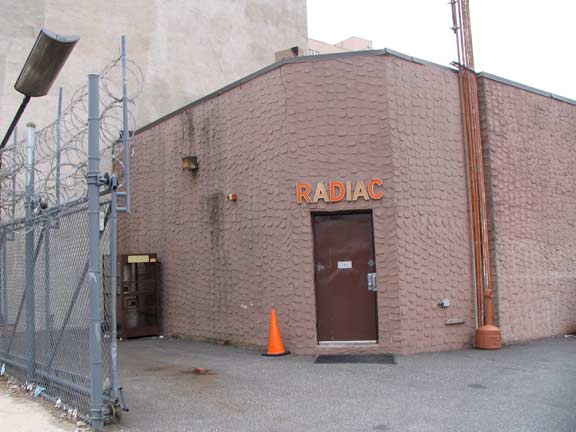
Radiac, Kent Avenue near Grand Street, a former handler and shipper of radioactive waste from such businesses as dry cleaners, medical offices and even print shops, has operated in the area since 1969, when Williamsburg was in forlorn slumber in north Brooklyn, not the entertainment and creative hotbed it became much later. Radiac finally stopped handling dangerous materials in 2005 for the most part, and became a transfer station.
Whenever I go by the place, though, I think of this…
57-61 Grand Street, a 5-story walkup building, contains a painted sign over the second floor advertising a long-lost business: “57 Iron and Steel, Thos. W. Kiley & Co. Hardware.”
Brooklyn Genealogy has some information about him in this transcript from the late 19th Century:
This business was established in 1847 by Mr. H. C. RICHARDSON, who conducted it till 1882, when he was succeeded by the present proprietor, Mr. Thomas W. Kiley.
Mr. Kiley is a thoroughly practical mechanic. All the operations of his factory are conducted under his personal supervision, thereby insuring to the trade only such products as will withstand the most critical tests. The factory is a superior three-story brick building, 41×100 feet in dimensions, fully equipped with all modern tools, machinery, and appliances necessary for the manufacture of builders’ hardware and other specialties. The machinery is operated by a fifty-horse power steam engine, and sixty experienced workmen, salesmen, etc., are employed in the factory and warehouse. The warehouse, which was erected in 1885, is a substantial four-story brick building, 25×120 feet in dimensions, admirably arranged with every facility and convenience for the accommodation of the large and valuable stock, which is unsurpassed fur quality, reliability, and general excellence by that of any other first-class house in the trade.
Here the carriage-maker, blacksmith, builder, mechanic, etc., can each have his wants supplied, and the great variety of goods to fill so many requirements adds greatly to the trade of this popular house. Several traveling salesmen are employed, who represent the interests of this establishment at the different centres of wealth and population in the Middle and Eastern States.
Mr. Kiley is a native of New York City, and is greatly respected by the community for his sound business principles and sterling probity. This house is one of the most responsible in its line in the country, and its trade is an important feature of the commercial and manufacturing resources of Brooklyn.
Kiley & Co. were hardware wholesalers and jobbers which probably made tools such as chisels, pry-bars, crowbars and wrenches, etc. [rootsweb]
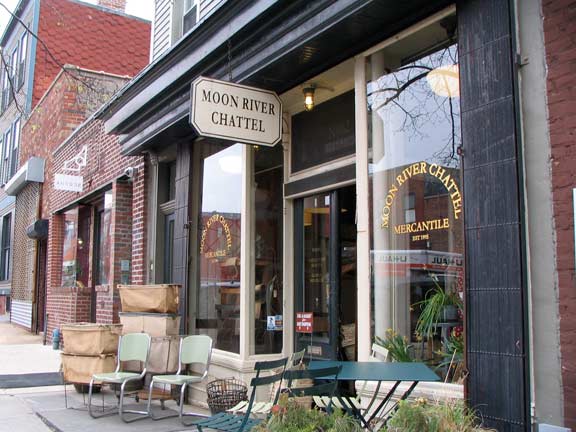
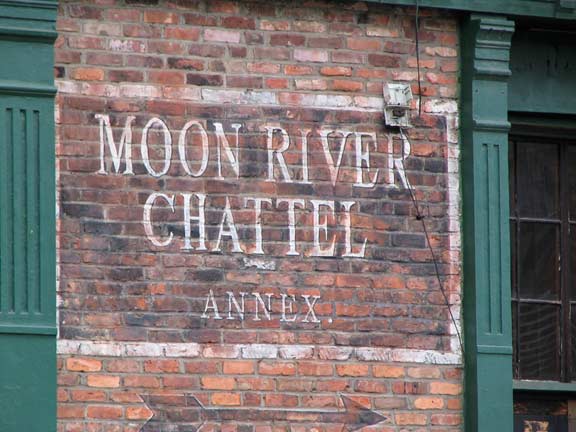
Moon River Chattel, a home furnishings and antiques store at 62 Grand, has placed a ‘prematurely aged’ painted ad on the old Kiley building across the street. Webster’s defines ‘chattel’ as: “an item of tangible movable or immovable property except real estate and things (as buildings) connected with real property” but I had only heard it in its slavery associations.
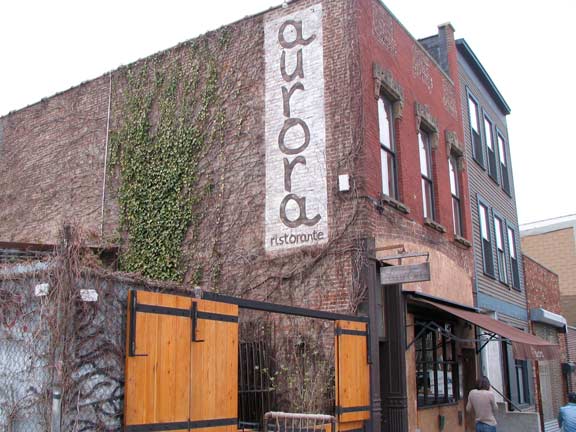
Aurora, an Italian restaurant near Wythe Avenue specializing in Tuscan fare, has a painted ad facing east.
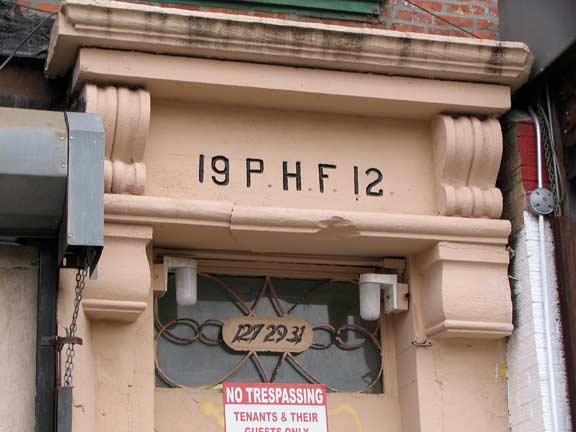
This sign over the doorway at 127-131 Grand Street, off Berry, has always baffled me. The 1912 likely refers to the date of construction. I’d guess that P.H.F. is the architect or original owner’s initials.
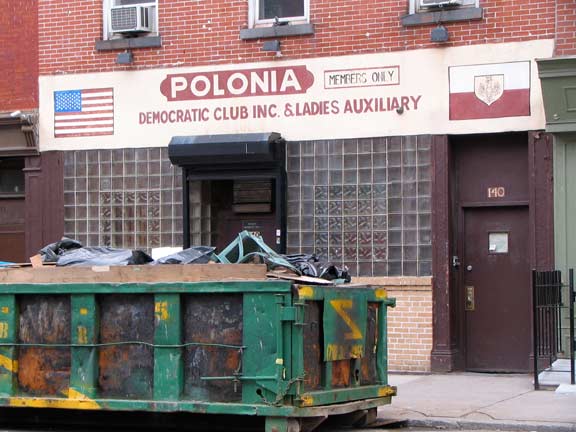
Old-school awning sign for Polonia Democratic Club & Ladies Auxiliary. The late Bill Reel, a Daily News and Newsday columnist for 38 years, always referred to his wife as “Mrs. Polonia,” referring to her Polish ancestry. The club’s presence here is emblematic of North Brooklyn’s heavily Polish and eastern European demographic.
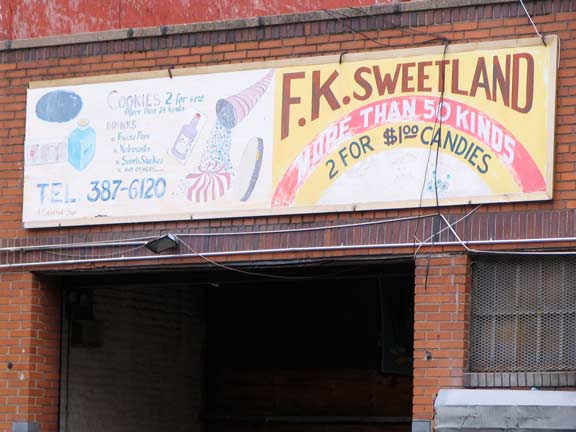
Next door, F.K. Sweetland is a fitting name for a candy and confectionary wholesaler. I wish I knew more about the place but the web is no help here.
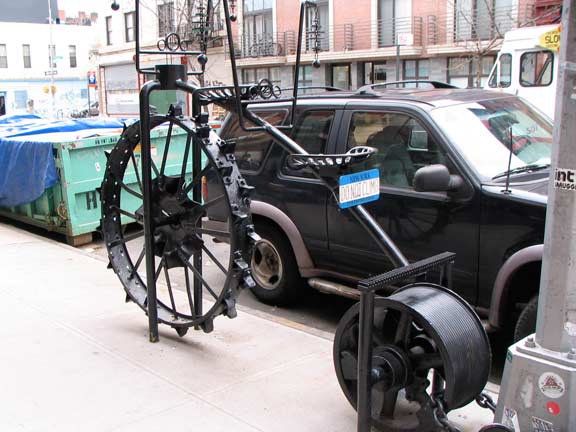
Easy Street, an art gallery at 155 Grand, had a sculpture of an old high-wheeler, or pennyfarthing, bicycle out on the curb.
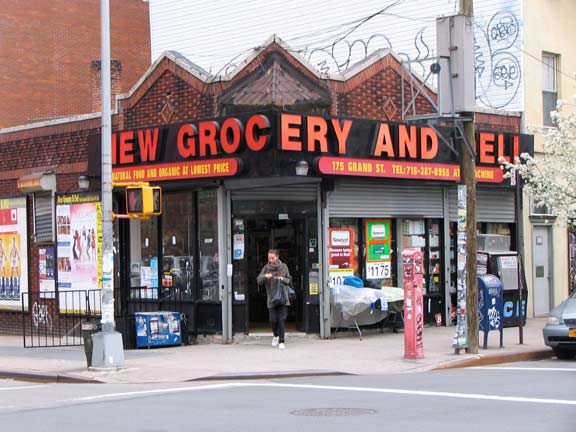
This is an unusual wraparound neon sign for a grocery at the NE corner of Bedford Avenue and Grand Street.
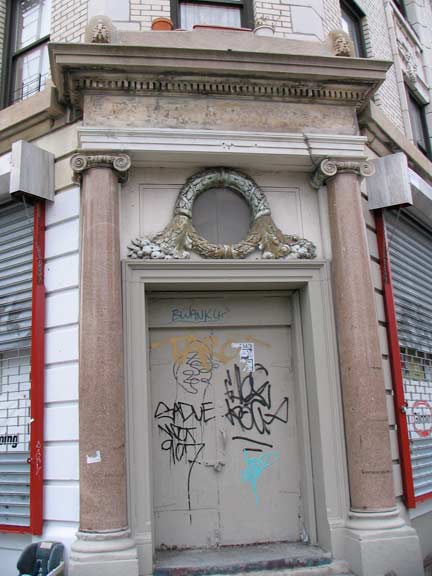
This entrance on the SW corner at Bedford hints at a grander past. This was likely a bank at one time and there may have been a clock over the entrance.
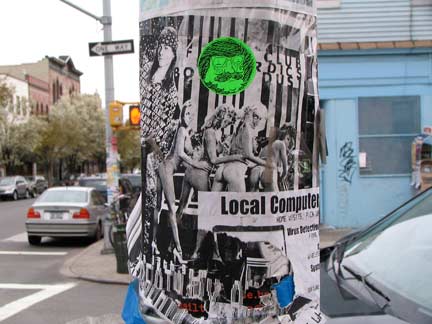
This ad for a local computer repair place on a lamppost at Bedford got me to look.
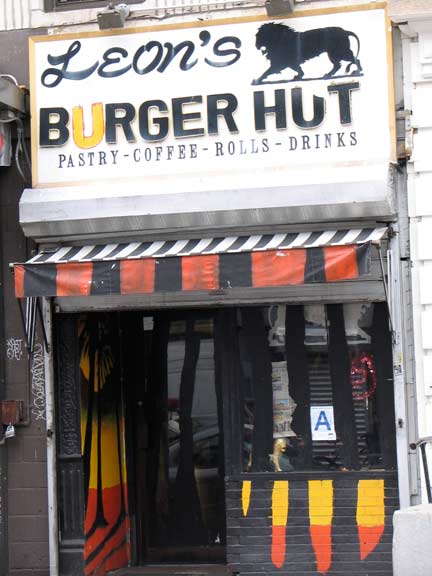
Leon’s, on Bedford just south of Grand, looks like my kind of place.
Vice had an interesting review:
If you’ve lived in Williamsburg for a while, you know how IMPERATIVE it is that you drop what you’re doing and go to Leon’s IMMEDIATELY. For the rest of you, Leon’s is a burger hut owned by a wizened old Lion of Judah who is excellent at burger craftmanship, but not so hot at the whole regular-business-hours or sometimes-ANY-business-hours game. Basically, this place being open is like the Halley’s Comet of delicious things that can happen to your mouth. Look, you’ve already wasted tons of time just reading this. We wish we could link our brains with yours just to communicate what a serious burger matter this is. Please leave RIGHT NOW.

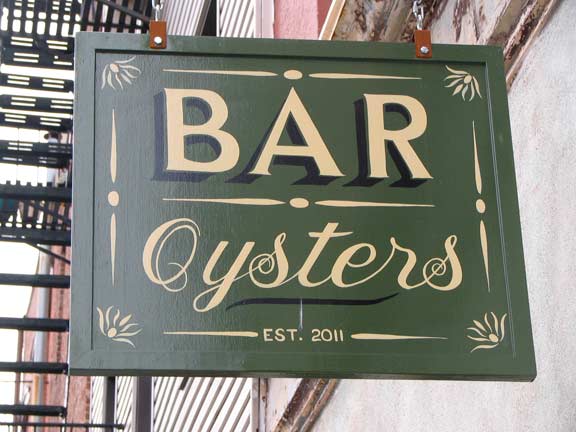
On the other hand I’ve always avoided shellfish, bivalves and oysters. Just too slimy and squishy. When I eat something, I never want to be reminded that it was alive, and I want to be assured that it’s been killed dead. (I have always admitted to having a 12-year-old’s taste in cuisine.) But that doesn’t stop me from admiring painted signs like this beauty over the otherwise austere exterior of Maison Premiere at 298 Bedford.
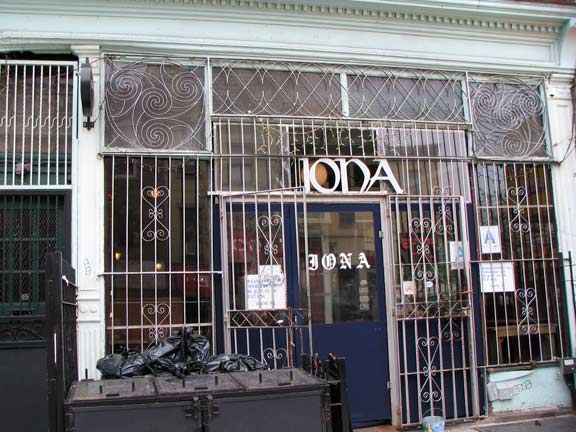
At 180 Grand east of Bedford, Iona is unusual as Irish pubs go, as the exterior is tricked out in wrought metal. The bar’s website says this was once a candy store. It’s named for an island off the coast of Scotland home to Irish monks for centuries; New Rochelle’s Iona College is also named for it.
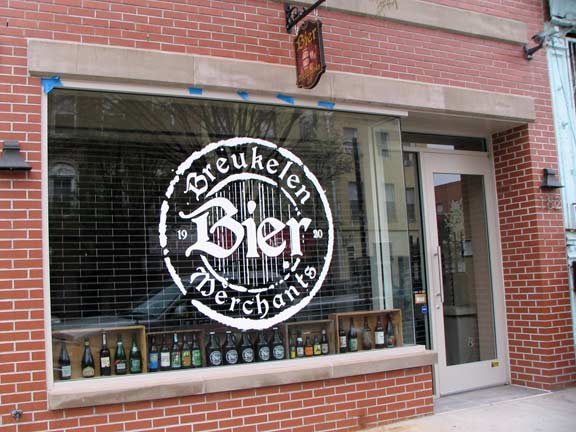
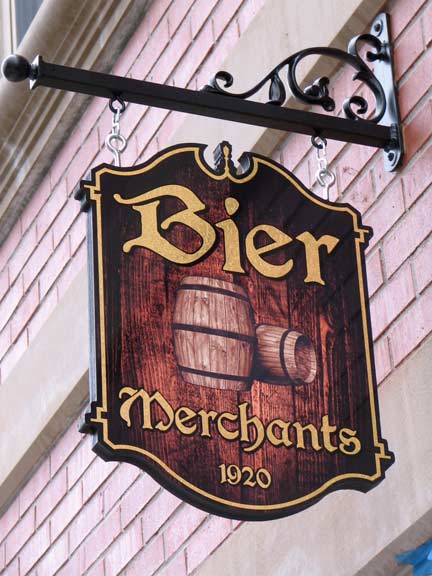
Yet another handsome painted shingle sign, this one at Breukelen Bier Merchants, 182 Grand, which seems to claim establishment in 1920.
[T]his place has sixteen of them on draft and 500 by the bottle…In addition to front and back seating areas, both equipped with heavy wood tables, there’s Wi-Fi throughout and victuals sourced from (where else?) local purveyors, including Schaller & Weber Bavarian pretzels, pressed sandwiches on Tomcat Bakery [based in Long Island City. -ed.] ciabatta, and even a beer-infused cupcake from Cupcakeland, nearby. A small provisions area in the front offers olive oil and other pantry goods. NY Magazine
Bier is beer in both German and Dutch.
Samurai Mama at 205 Grand offers an awning sign in the Mesquite typefont, as well as artwork featuring people dressed in what appears to be Victorian-Japanese gear. The menu features udon, variants on noodle soup, as well as other cooked items rather than the usual sushi.
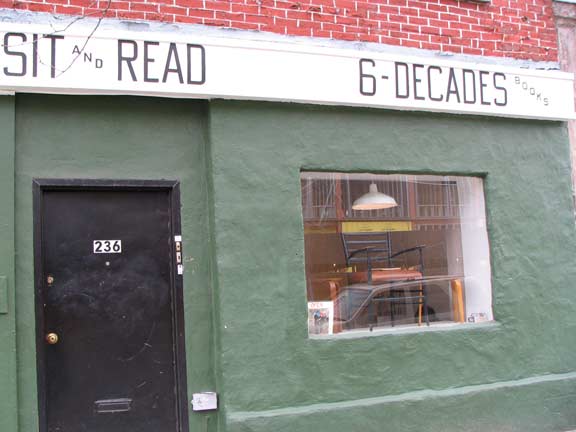
Sit and Read Gallery, 236 Grand, near Roebling, is a branch of 6 Decades Books, whose home base is on Canal Street in Manhattan. The minimalist signs are likely hand-lettered.
According to its website, 6 Decades is dedicated to artists’ books, the history of the book as an artistic medium, and to documenting the essential role these books have played in the development of contemporary art.
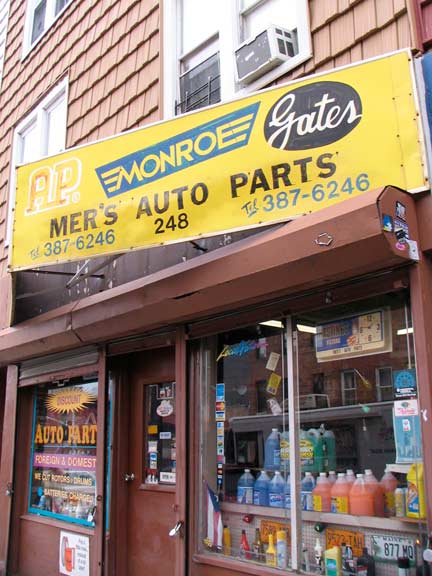
Meanwhile the old Grand Street guard is hanging in.
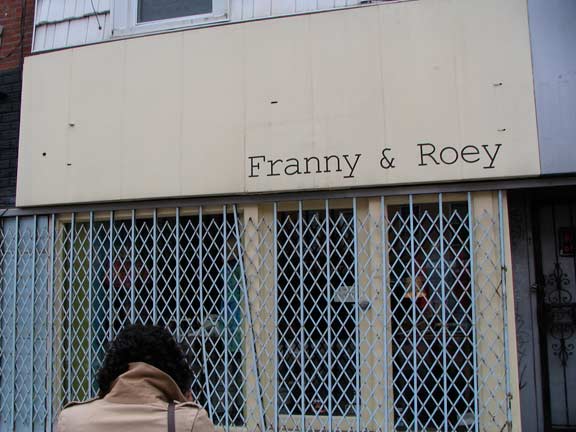
This vintage clothing and accessories store is designed to look like a teenager’s bedroom from the seventies, complete with a twin bed, olive green walls, and a record player stocked with Beatles and Bob Dylan albums. Franny and Roey is a play on the owners’ names, Ilyane Roey and Frances Pezik, as well as a nod to J.D. Salinger’s popular 1961 book, Franny and Zooey. New York Magazine
It was, anyway, since it has been closed for awhile at 252 Grand. That’s about as minimalist an awning sign possible, using the generic computer font, Courier.
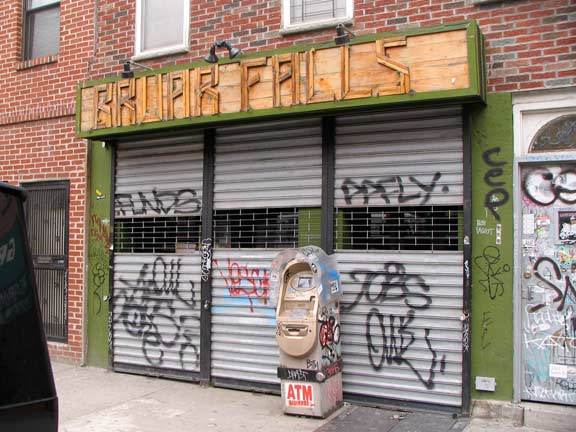
Music venue Bruar Falls at 245 Grand closed in the fall of 2011 but its homemade woodcut sign was still there when I went past.
Fuego718’s awning sign says “you are loved” in 20 languages. Can you identify them? 249 Grand Street, Mexican/South American-themed gift shop. I see Day of the Dead items and luchador masks in the window.
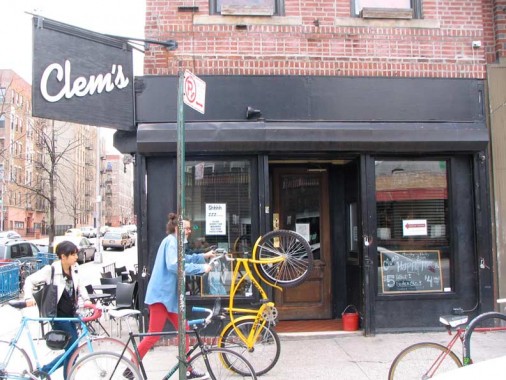
Clem’s, at the SW corner of Grand and Roebling, opts for a black facade with a white-lettered shingle sign. Here is an inside view.
Clem’s opened nine years ago [2002], in a former liquor store that had a bulletproof window where you’d slide your money in and a bottle would come sliding out.
“Back then,” said John Clement, the bar’s owner and a sculptor who lives in Williamsburg with his wife, Jean, and their two young children, “we’d find nine-millimeter shells in the street outside.” NYTimes
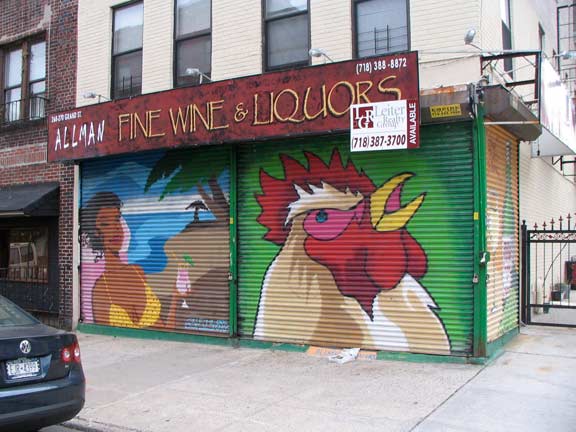
When I passed by Allman Liquors at 268-270 Grand had already turned over, but it boasted a handsomely typeset awning sign and a roll gate decorated with a rooster and an island beauty.
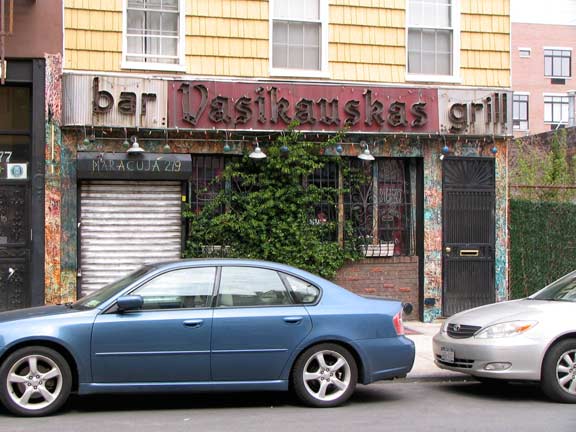
I’ve never actually seen Vasikauskas Bar & Grill open at 279 Grand between Roebling and Havemeyer, but that was a righteous neon sign installed decades ago.
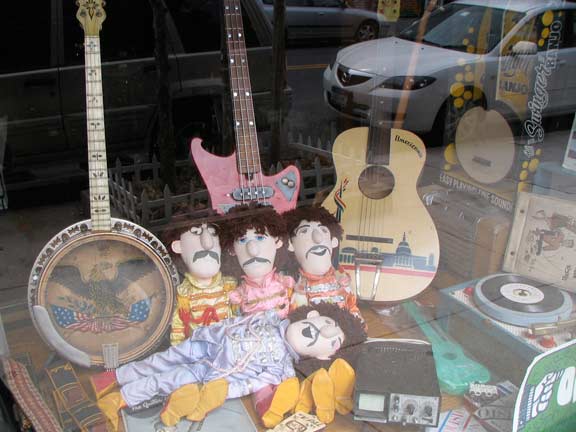

Southside Guitars, 303 Grand Street. When owners (and brothers) Sam and Ben Taylor were fixing up this Williamsburg space for Southside Guitars, they uncovered a stash of stale drugs in a crawlspace and a rusted police revolver buried in the backyard. These discoveries lent the place nearly as much rock-and-roll cred as the storied instruments inside. NY Magazine
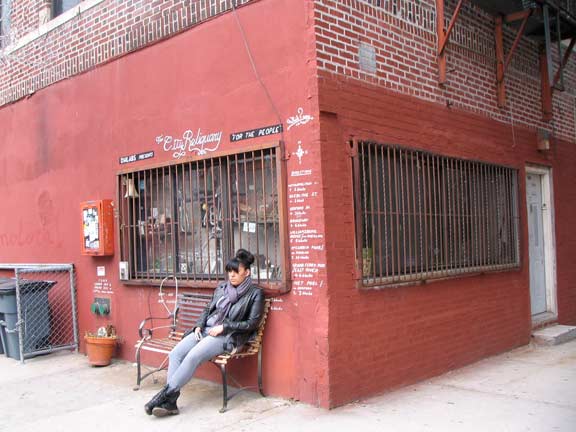
Original City Reliquary window, NW corner Havemeyer and Grand Streets. I’ve known about the City Reliquary for over 10 years since it was founded by firefighter Dave Herman — it’s a true museum in every sense of the word, showcasing NYC memorabilia and kitsch from several decades here and in its storefront location around the corner at 370 Metropolitan Avenue.
State of Liberty postcards, terracotta fragments of landmark buildings, subway tokens, geological core samples, paint chips from the L train, and a “very old shovel” each tell their own story of New York City’s past. Rotating exhibitions of community collections can be seen in the storefront window: giant pencils, copper jelly molds, pulleys, and flashlights – each celebrate the community of New York’s present. City Reliquary
In the summer of 2010, FNY was proud to curate a look at NYC lamppost history at the Reliquary with NYC’s King of Lampposts Bob Mulero, who owns hundreds of photos of NYC light poles, which turns your webmaster several shades of green.
![]()
PART 2: east of the BQE
In Williamsburg, Grand Street is effectively cut in two by the Brooklyn-Queens Expressway, though a piece of it runs west from Union Avenue to Marcy Avenue, crossing the BQE. It was cut through in the early 20th century as the Grand Street extension, but in a nod to the Puerto Rican population in south Willie, it was renamed Borinquen Place in the mid-1970s.
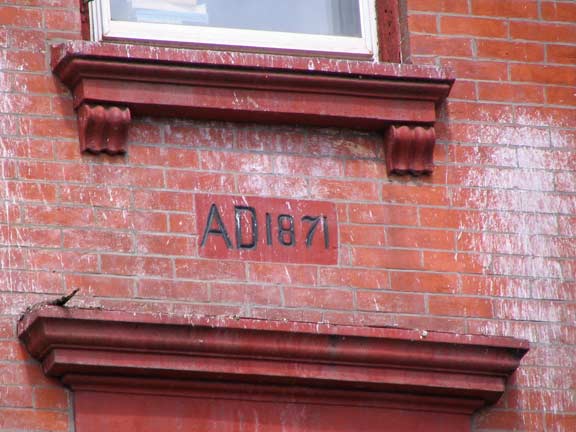
This tiny inscription between the second and third floors of a brick building at Grand and Borinquen reveals the date of construction. Secrets like this reveal themselves, the more thorough you are about regarding them.
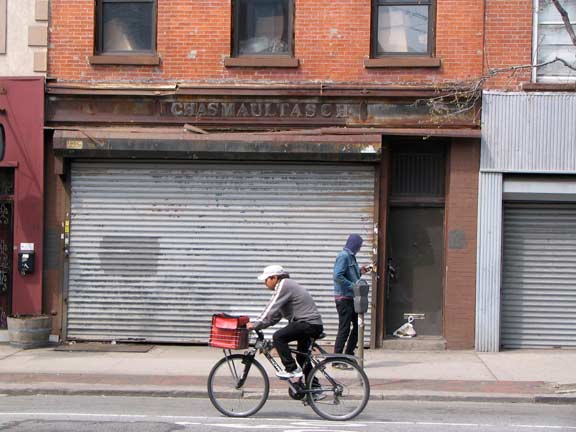
In the New Willie, when you see an old-fashioned-looking sign, you’re never sure if the shopkeeper is presenting it as a clever hommage, or an ironic dig. But sometimes you’re looking at the real McCoy. That’s what this awning sign (CHAS. MAULTASCH) on 535 Grand Street east of Union Avenue is. The indispensible ad sleuth Walter Grutchfield:
Charles Maultasch (1883-1938) ran a dry goods store at this location from 1920 until his death in 1938. Maultasch was an immigrant from Galicia/Austria who registered for the World War I draft in 1918 when he was 35 years old and self-employed at his dry goods store at 535 Grand St., Brooklyn. In his application for naturalization filed in 1906 Maultasch stated that he was born 19 Nov. 1883 and that he had lived in New York City since July 1901. This document is hand written and not easy to read, but his address at that time seems to be 191 Attorney St., Manhattan.
The New York City telephone directory listed Maultasch in business at 205 Grand St., Brooklyn, from 1918 to 1920. Then in 1921 the address changed to 535 Grand St. In the 1920 U. S. Census Maultasch lived at 535 Grand St. His family included his wife, Anna, and three children, Diana, age 5, Milton, 3, and Ruth, 1 year and 5 months. In the 1930 census Maultasch still lived at 535 Grand St. His family now included a third daughter, Bernice, age 9.
In July, 1938, the New York Times reported that Maultasch’s estate had been appraised at $12,679 gross assets. Primarily this consisted of real estate appraised at $11,000.
Following Charles Maultasch’s death in 1938, the business at 535 Grand St. was continued by his son, Milton Maultasch (1916-1994), until 1976.
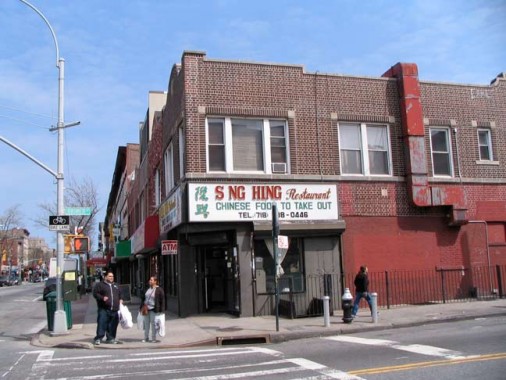
Sing Hing Chinese Restaurant, SW corner Lorimer and Grand Streets. Nice combination of plastic letters and handlettering. Do Chinese restaurant names actually mean anything, or are restaurants with names like FOOK HING do that with a wink?
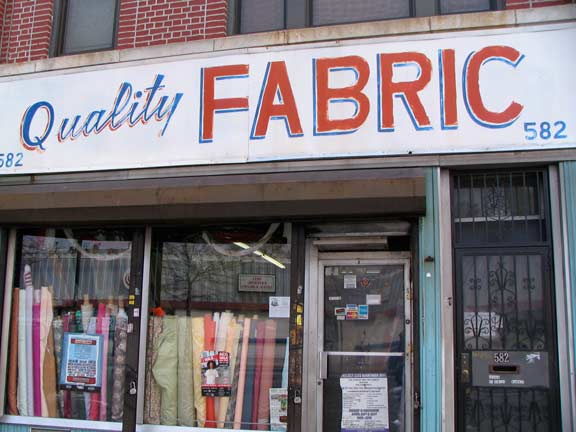
East of Union Avenue on Grand, we’re out of the artistic Willie and more into the everyday humdrum get-on-with-it Willie, and you begin to see some unironic or unartistic handcrafted signage, like this one at 582 Union. This was probably lattered with a ruler and a T-Square several decades ago.
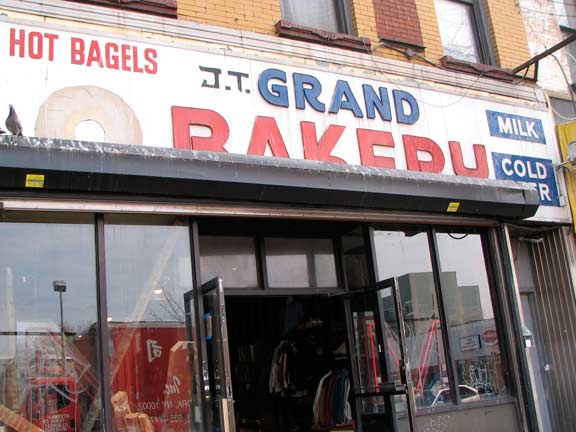
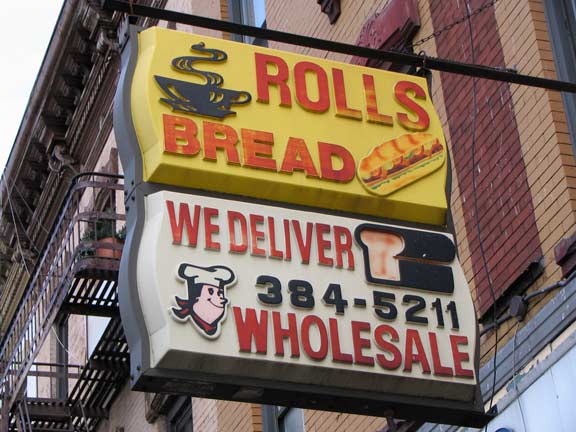
Before vinyl awning signs became so ubiquitous and after wooden signs fell out of vogue, signmakers worked mostly in neon and its cheaper alternative, plastic, as in plastic letters affixed to metal or plastic backgrounds. Sometimes on ‘shingle’ signs extending over the sidewalk, a plastic shell illuminated by lightbulbs would be employed.
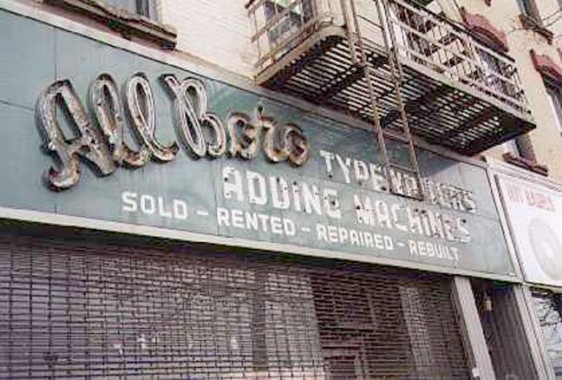
Late and lamented: on a walk down Grand Street in 1999 I found this neon sign for a typewriter repair shop. This site is currently a Papa John’s which approximates pizza.
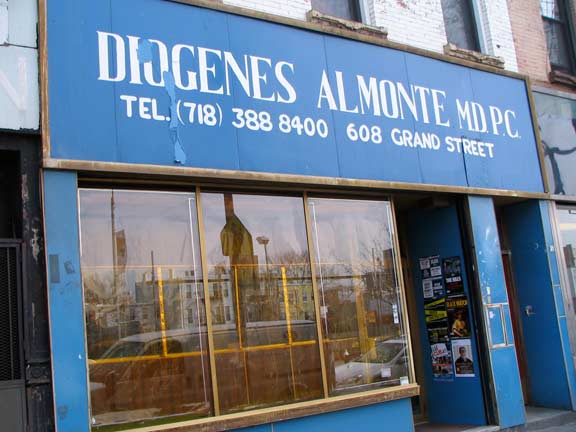
Handlettered (with serifs!) sign for pediatrician Dr. Diogenes Antipas Almonte at #608. His name is interesting and combines two religious traditions. Diogenes of Sinope was the famed Greek philosopher (412-323 BC) who slept in a large jar and carried around a lamp, saying he was looking for an honest man, while Antipas was an early Christian saint, while less pleasantly, a nickname of Herod, provisional ruler of Galilee under the Romans in the time of Christ.
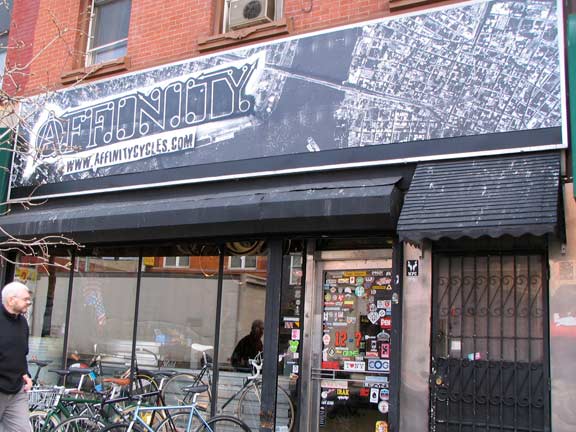
Hand-drawn art combined with an aerial view of Williamsburg for Affinity Cycles, 616 Grand. This is truly a one of a kind awning sign.
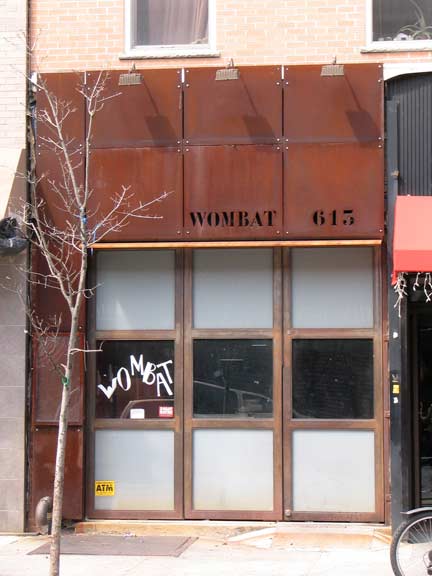
Wombat at #615 Grand near Leonard is one of the few Australian restaurants in the NY area, if you don’t count the Outback chain places. But wombat or kangaroo is not on the menu.
Creeping toward Bushwick from the saturated Williamsburg dining scene, Wombat also set up shop beyond an established thoroughfare. Statelman’s latest effort — he is coming off of a seven-year stretch at Smith Street’s Patois — is an “Aussie-style” menu that highlights Australian cheese, wine and spices (he gets the herbs from importer Vic Cherikoff, an authority on Australian native flavors).
Ingredients like lemon myrtle, bush tomatoes and wattleseed elevate even Wombat’s most ostensibly familiar fare. The chicken panini, for example, is topped with bush tomato mayonnaise and Australian cheddar, imparting a distinct Australian slant on the common sandwich. Statelman plays with the evolution of the country’s culinary hallmarks, as when he brings in game meat for his Soy-Cured Venison Medallions served with a Sriracha buckwheat fritter, or reinterprets the iconic pie “floater” — his uses a flaky poached chicken Wellington in place of the traditional meat pie.
The growing presence of Australian cuisine might well represent a larger shift in New York dining trends — one that reflects a departure from the precious, elegantly crafted plates of the last decade in favor of a hearty, deeply satisfying meal. For Brooklyn diners, that’s a meaty prospect to be sure.
Say what?
If you want to speak like a local and navigate the latest wave of Australian menus, take this crash course in Aussie food lingo:
Adam’s ale: Water.
Bottle-o: A liquor store, also referred to as a bottle shop.
Bum-nuts: Eggs.
Bush tomato: Also called desert raisins, these small native berries are often dried and ground to impart a tangy tomato flavor to a range of foods.
Floater: An Australian meat pie served in pea soup and drizzled with tomato sauce. Commonly thought of as a “drinking food.”
Lemon myrtle: A common bush food prized for its lemon-flavored leaves, they impart a citrus flavor to milk-based dishes that might curdle with the use of actual lemons.
Milk bar: The Australian equivalent of a bodega.
Plonk: Cheap wine. Rumored to be descended from a heinous mispronunciation of the word “blanc.”
Pot, schooner and pint: Three sizes of draft beer (10 oz., 15 oz., and 20 oz. respectively).
Tinny: A can of beer.
Tucker: General term for food, though more directly references “bush tucker,” another name for Australian native food.
Wattleseed: A variety of the Acacia seed with qualities akin to coffee. Wattleseeds are often roasted and ground for use in a variety of foods. Brooklyn Paper
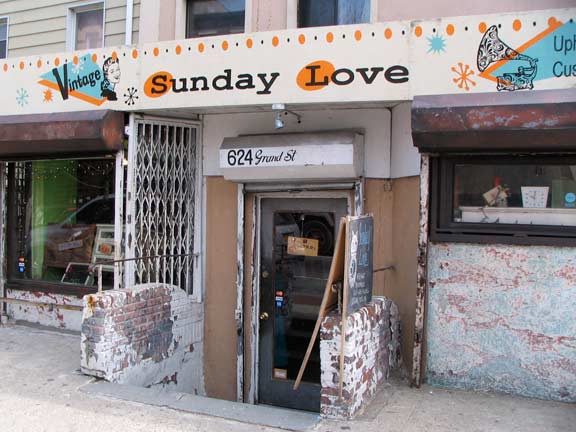
Sunday Love, a thrift shop at #624, combines clip art and Courier Bold, as well as aqua and orange (Miami Dolphins fans perhaps?) on its appealing awning sign.
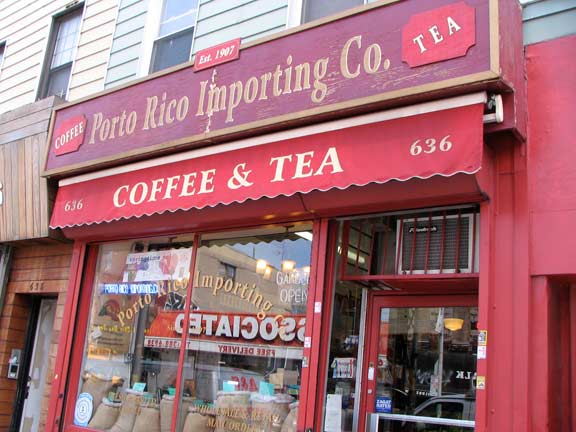
At #636, the Porto Rico Importing Company, dealing in caffeinated comestibles, is not a misspelling: this branch of the Greenwich Village Bleecker Street location used the former spelling of the Caribbean commonwealth.
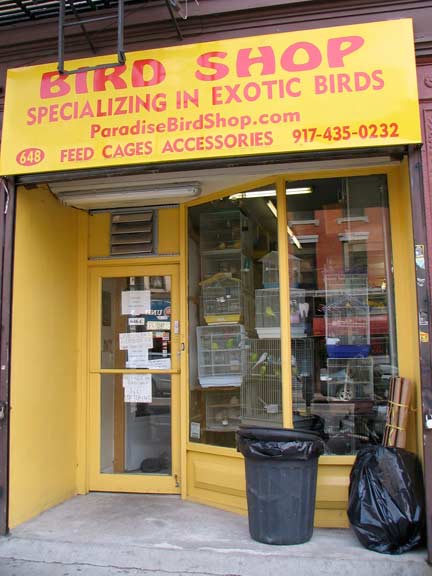

At #648 the Bird Shop employs yellow and red, a color combination usually found on Latino food shops. The font used for the shop name is an unusual yet welcome one: Hobo, a venerable face designed by Morris Fuller Benton as long ago as 1910. Benton also is responsible for Franklin, the font I use on my FNY title cards.
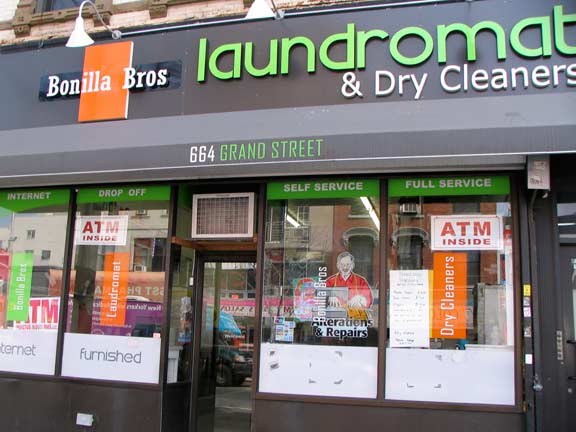
The Bonilla Brothers chose a variant on Gill Sans on their black, white, gren and red sign at #664.
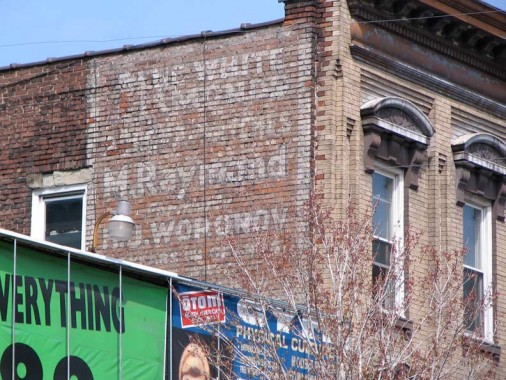
Here’s an ancient painted ad on the north side of Grand that has mostly held up for the greater part of a century. I can’t make out the first three lines, but two names, M. Raymond and H.J. Woronov, stand out, I’m reminded of Mary Woronov, who debuted in Andy Warhol’s retinue and went on to make dozens of nonmainstream pictures, including Rock & Roll High School and Eating Raoul.
Latin cuisine Los Primos, at #704, employs what looks like a colored terra cotta awning sign. I had to look at it for a few minutes to figure out it said “Primos.” I also noticed a very ancient doorway adjacent to it…
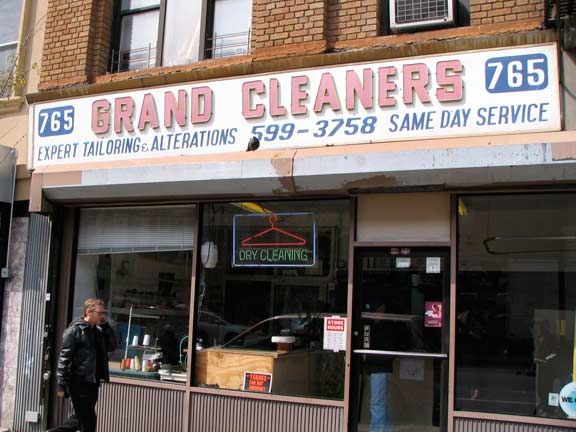
Another classic red, white and blue sign at #765. between Graham and Humboldt. A smaller neon sign featuring a wire hanger is in the window. Joan Crawford would not have approved.
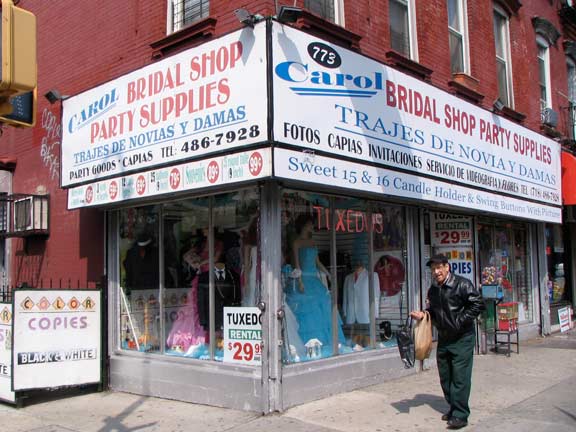
On the NE corner of Grand and Humboldt is a much-busier sign, also in red, white and blue. There’s a lot of fonts going on too — on signs designers should usually stick to two at most. On the corner, the shopkeeper has the advantage of being able to use two signs.
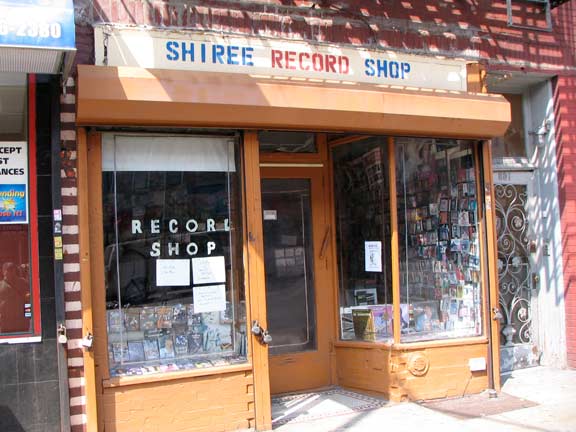
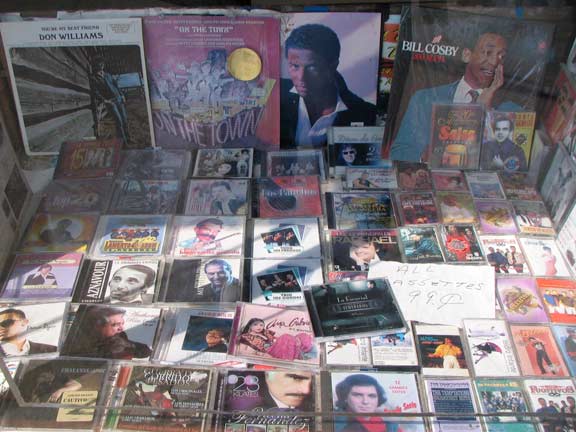
It took about 60 years for vinyl LPs sto take over from hard lacquer 78s, and then another 30-35 or so for CDs to take over from LPs, with a strong challenge from 8-tracks and cassettes in the 1970s. MP3s, which don’t require a cover or artwork at all, became widespread beginning around 2001 with the advent of Apple’s ITunes and in only about 12 years, seem primed to wipe out CDs.
But until then the Shiree, near Bushwick Avenue, with its handmade stenciled awning sign and display window full of vinyl and discs will survive.
This classic maroon and beige delicatessen sign, at #855 between Bushwick and Waterbury, is so nice I’m showing it thrice. Someone should revive this style of signcraft, classic in every way.
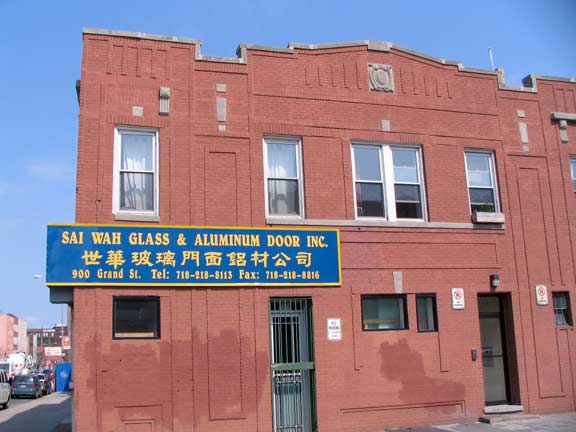
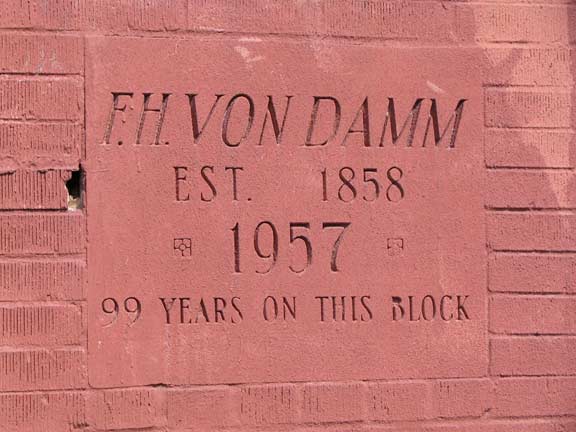
This sign on the corner of Waterbury uses the somewhat unusual Belwe font (designed by German typographer Georg Belwe in 1907), but my eagle eyes noticed a historic sign commemorating a longtime area resident.
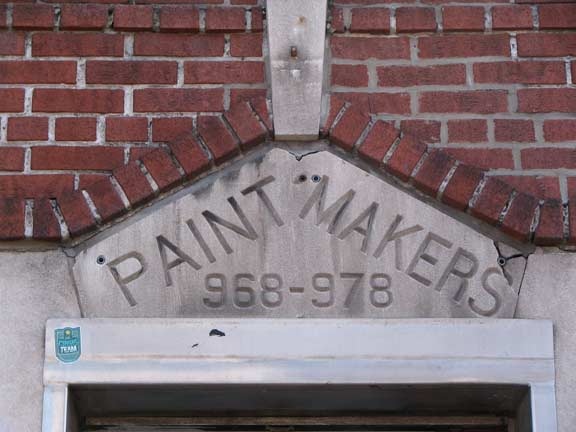
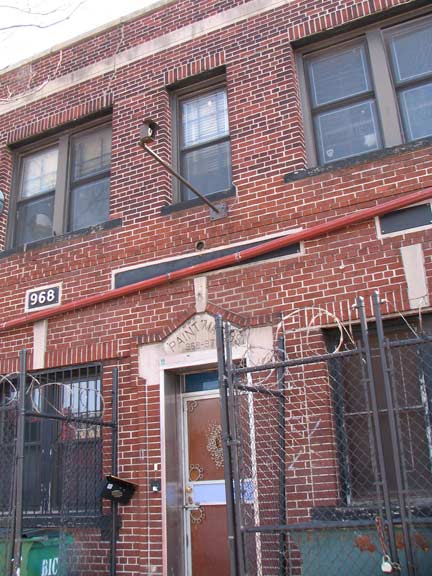
A chiseled sign at #968-978 leaves no doubt about the original purpose of this brick building.
Finally, on the easternmost end of Grand Street in Brooklyn, at Gardner Avenue near the ancient Grand Street Bridge, is Charles J. King Iron and Steel Scrap. The black and white signs seemed newly repainted on the building when I encounterd them.
1/13/13


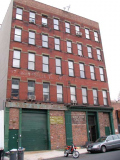
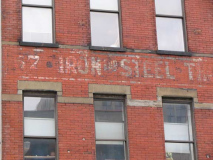
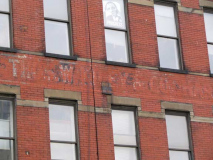
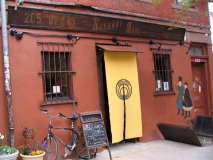
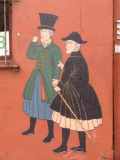

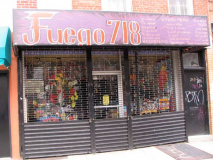
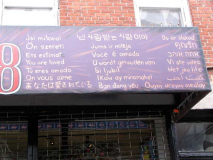
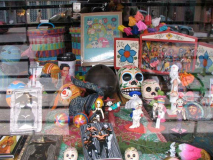
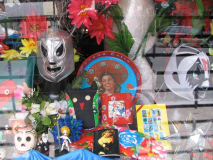
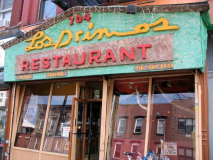
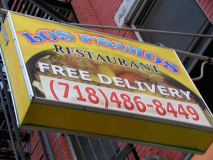
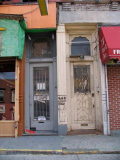
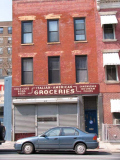

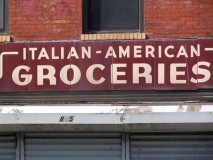
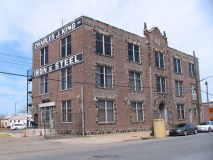
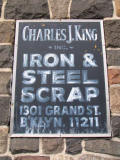
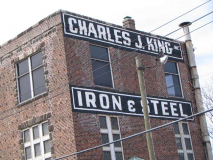
12 comments
3 quick bits:
1. It looks like that mystery wall ad says “blue white diamonds” on the first two lines.
2. I also immediately thought of Mary Woronov (Rock n Roll High School is one of my favorite movies because I’m a huge Ramones fan)
3. I wonder if that Latino record store is the one recently in the news (blogs?) about receiving complaints from a gentrified immigrant or two for playing music loudly and the local pol citing cultural needs as requiring exemption from the law (a fight with no winners).
First line is “Fine” white almonds. Third line looks like “sandwiches”, while 5th line looks like “formerly”. So it’s possibly bleed-through read-through.
Just looking at this fascinating set of photos, and wanted to correct your comment. While you’re correct about the “formerly”, the first line is actual “Fine white diamonds”. The sign says “Fine white diamonds”, followed by something illegible (but unlikely to be “sandwiches”), followed by “M Raymond formerly H.J. Woronov”. H.J. Woronov used to live at, and own a jewelry store on, 717 Grand St, on which this awesome old ad was painted.
Regarding the building at the SW corner of Bedford and Grand, while it may or may not ever been a bank, I remembered it in the 70’s and 80’s as a church affiliated with a small Eastern Orthodox sect. I think it was actually called a cathedral! The guy who ran the operation worked for the Williamsburg poverty program and, after it closed, sponsored several community carnivals. I always saw him as being something of a scam artist. But he certainly looked the part, with his striking gray hair and flowing robe. The “cathedral’s” congregation, if you could it that, was certainly very small.
Keeping these plants in flowerbeds or flower boxes near your home will attract tachnid flies, who will then help
control the population of earwigs. They can thrive in just about any environment and are less reliant on
moisture than other roaches. One popular bathroom fixture
today that many interior decorators and home owners use is a shower bath.
my web site :: Mia
I have a piece of jewelry that has its owned lined box that says H.J. Woronov 727 Grand Street Brooklyn NY. it is too bad you do not have a picture of this address to go with the painted ad you did have. Not sure if the hunting case watch was made or bought at this address, but it is interesting.
My guess is that the address on your jewelry is actually 717 Grand St, since that was the address of H.J. Woronov’s jewelry store back in the 20s and the building on which that faded sign was painted (visible in this Google Streetview location).
One more HJ Woronov-related item: The store moved, or the chain consolidated, to Jamaica Avenue at some point in the 20s, before 1929, as can be seen in the attached newspaper scan, which shows a large ad, mentioning that they were formerly of 717 Grand and that the Jamaica location is “now our only store”
Just found a small box with Woronov’s Jewelry store information, I can’t seem to find what years they were in business…any ideas?
Quality content is the main to interest the visitors
to pay a quick visit the website, that’s what this web page is providing.
I always enjoy forgotten New York . I often randomly come across it. I found some more information about Thomas W Kiley while searching for info on a vise manufactured by them. It see Thos had another vice: Polygamy! It was front page news in 1906 “MilLIONAIRE HAS TWO WIVES KEEPS BOTH IN LUXURY”! https://chroniclingamerica.loc.gov/lccn/sn83030193/1906-03-21/ed-1/seq-1.pdf Wife number 1(his brother’;s widow) was in poor health. He thought she would die. He married wife 2 and wife 1 got better. So he put wife 2 up in a house 1/2 mile from wife 1. Wife 2 sued Thomas, becasue she thought she would get none of his estate if he died and this all became public knowledge. The company was in business up until at least until 1948 https://books.google.com/books?id=UeAXAAAAYAAJ&dq=Thomas+W+kiley++++57+grand+st+brooklyn&focus=searchwithinvolume&q=Thomas+W+kiley+
Harry J. Woronov (1874-1826) started in business at 727 Grand around 1895 and moved to 717 Grand some time between 1909 and 1912. He was still in business in 1921.